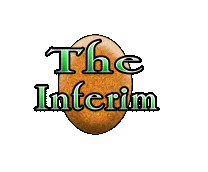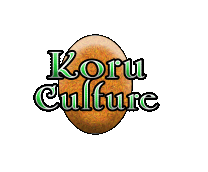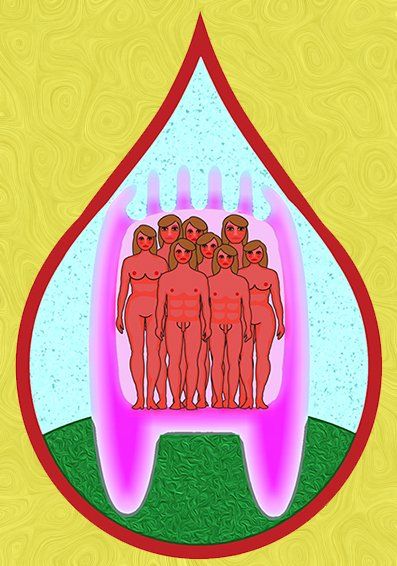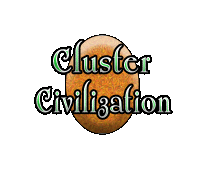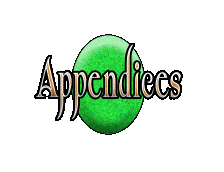
Rural culture and traditions contain some of the most ancient of ongoing customs, particularly those of the ‘baby mother’ and ‘sprouting mother,’ along with fishery craft
practices, forming an unbroken set of conventions that are steadfastly adhered to by present-day rural clusters.
These agricultural rituals originate early in the Lesser Era of the Primary Epoch and the long march of prehistoric ages employing agriculture before it.
Rural rooted in Urban
Role of Ablution Academies in rural life, Balance and integration of urban and rural, Rotation of Dramatists and Scholars, Rural Invocates, Rural Enclaves, Improvement of select rural circles
Rural Cluster Property
New cluster established, Increase or decrease in cluster population affects property allotment, Upata Bulb innovations, Water Sharing, Bowvow Tree and Hungry Rock Sharing, Keepers, Keeper Icon, Cluster-of-Clusters Property
Rural Cluster Creatures
Venerable Insect Societies exception
Gandahatapan, Gandahatapan and Mahakram, Protection of Mahakram Arbours, Raw Mahakram and Yakku Tales, Instituting Ketukku Kingdom
Four Yeldic Gateways
Principal and Secondary Crops
Salarish
Salarish Agricultural Calendar
Summer One, Summer Two, Summer Three, Summer Four, Summer Five, Mid Year, Summer Six, Summer Seven, Summer Eight, Summer Nine
Charsha
Fecund Farms
Fertility Rites, Death Feeding Life, Blossom Silence, Egg Planting, Mahakram colonies within Fecund Farms, Fecund Mahakram, Mahakram Arbours
Fishery Craft
Fish hierarchies
Gelfion
Camalus
Once a predator, Camalus harvesting and culling single Gelfion, Camalus and Chupukam, Eight-to-One Circle Rating
Nemain
Circular profile, Oil highly prized, Morning music, Abuse of oil, Small pools, Sixteen Circle Rating
Halahala
Jizo
Serpents
Worms
Invisibles
Waterfowl
Varox, Kishilion, Raiden and Raideneth, Raiden prolific egg layers, Associated with comedy and fertility
Rural Rooted in Urban
Role of Ablution Academies in Rural Life
While the Cluster-of-Clusters Nation
is founded on various forms of agriculture, the Uluvatu Masters foresaw the vital need for integration between ‘unremarkable’ rural communities
and the essential revitalizing elements of urban civilization.
Funomanru
and other pre-Tatchlan
historians had long noted the history of rural life was essentially unchanged through time. While an essential activity, it was also marked by hardship, monotony, isolation and backwardness. Early in the Primary Epoch, the first generations of Majastas
oversaw the institution of a network of Ablution Academies throughout the hinterlands to become focal points for rural cluster
life.
Balance and integration of urban and rural
Rural Ablution Academies
are in some ways identical to their urban counterparts, but there are a few key differences. While Face Days and other universal events occur on the same schedule as in urban centres, additional elements are unique to the rural region. For instance, in districts cultivating Salarish, all activities are set up to accompany and augment the Agricultural Calendar. Clusters engaged in Charsha
cultivation, those nurturing Fecund Farms
and those involved in the practice of Fishery Craft have slightly different observances at their treasured Mantle Establishments. While in each instance, the timing of specific observances is tailored to the locality, the Granaries and Custom Houses Bureau
of the Cycles Ministry, the Erudite Bureau
of the Enumerator Ministry, the Pacifier Bureau
of the Wellbeing Ministry, along with all five bureaus of the Ceremonies Ministry
ensure Cluster-of-Clusters standards are maintained.
Rotation of Dramatists and Scholars
A significant portion of most professions involves following proscribed routes to serve within a series of rural Ablution Academies
throughout the year. The aim is to maintain parity between urban and rural general cultural refinement and sophistication levels. This can only be achieved to a limited degree and is intended to inhibit aesthetic and intellectual disparities between rural and urban clusters. The need for specialization dictates that more profound disciplines are less represented in rural settings. At the same time, precise esoteric work related to aspects of rural life is carried on to a greater degree in remote locations.
Rural Invocates
Invocates
are essential to the full functioning of the entire Cluster-of-Clusters Nation. One vital portion of their service comes from their being able to reach distant minds within the Living System of Tatchlan
and thus bring news and information to isolated locations. In this capacity, they serve as crucial links for visiting and stationed professionals in rural settings, knowing trending events to their work transpiring in distant urban centres. For this reason, a cohort of Invocate circles is stationed permanently at each rural and urban Ablution Academy.
Rural Enclaves
While, for many reasons, most Enclaves
are found in urban centres, all five classes exist within the rural hinterland. Their placement and distribution are determined with great care by the ministries associated with each class and are always related to an Ablution Academy
of the region. As in urban centres, the Drone
and Farmer
are the most common Enclaves known to rural clusters, while the Queen
and Soldier Enclaves
are the rarest.
Improvement of select rural circles
While Ablution Academies
and Invocate Enclaves
do much to bring civilization to benighted regions, rural cluster Elders
also select certain circles
for ‘Improvement.’ This involves them leaving their cluster
and travelling to the heart of an urban centre where an urban cluster hosts them for some time. During their stay, they are immersed in the aromas of urban life in all its forms, including travelling to many sites of historical interest and partaking in public and cluster ceremonies. When they are deemed ‘Saturated in Improvement,’ they are returned. They are tasked with imparting their enrichment to their cluster and surrounding clusters. Once again, their local Ablution Academy plays a crucial role in providing the setting for several dramatic presentations put on by this circle to impart their experience and thus cultivate new depths of elegance and enrichment in their region.
Rural Cluster Property
New cluster established
The province marks out a new rural cluster's territory before establishing it. Many factors determine its extent. An account of the land’s fertility and other features is taken, including the provincial and regional parameters and the new cluster's impact on its neighbours. The cluster is expected to maintain this area until it reaches its full capacity. Then, they will remain constant near this size, taking inevitable reverses and declines due to crop failure and other difficulties into account. Disease, another calamity, and other unforeseen and uncontrollable events may force a cluster to relocate.
Along with the Province, the Ministries of Wellbeing, Cycles
and Enumerators
are informed of these developments. Planned changes include diminished births to deaths, scent separations
to other clusters, or opening themselves to absorb or be absorbed into a neighbouring cluster. This would lead to an amalgamation and integration of both territories.
An increase or decrease in cluster population affects property allotment
Should many scent separations
occur at some point among the merged clusters,
leading to the formation of a new cluster, they have the right to petition the province and even the Grandee Secretariat
for a portion of the combined territories appropriate to their numbers and ability. They shall act as a serving cluster to the larger group. Should the new cluster be directed to migrate away from the parent cluster, they lose all title to their former land. They are apportioned new land or relocated to an urban, coastal, or another setting.
On the occasion of additional scent separations from the cluster, the combined territory will be portioned among the group of clusters. Observers from the local Assizes Office representing the Adjudicator Rural
are present to provide impartiality and fairness. The smaller clusters will continue to act as servants to the largest cluster. Should the separations reduce the population to a large group of similar cluster Grade, there are two main options. It is preferred for the new group of clusters to form a harmonious working relationship with each other. The likelihood of success is based in part on the ‘Rule of Accordant Tones.’ If the two clusters are deemed to be of ‘Companionable Tone,’ there is confidence in their achieving a shared prosperity. If their Tones
are ‘Complimentary’ or, at worst, ‘Incompatible,’ a Maja Gathering
is convened to determine how best to proceed. The resulting recommendations are forwarded to the province and relevant ministries. As a result, some of the clusters may move to other territories. On occasion, the Majastas
have deemed it necessary to induce a general scent separation to ensure a clean break between different clusters in such a group.
Upata Bulb innovations
Significant changes occurred with Upata Bulb's
introduction in the Emaxul Age
of the Danam Yelda. Unlike urban settings, which avidly embraced this innovation, rural clusters
were far slower to convert from their traditional inert to living cluster compounds. Some of this was a matter of practicality given their Uses. The demanding observance of their agricultural and breeding calendars
also made preparations challenging. There was also the matter of the necessity of the Bulbs forming into Duets, Trios, Quartets, Quintets, Sextets, Septets, and even Octets
of bonded groups of Bulbs to nurture their larger populations. Despite the specialized breeds of Rural Bulbs, able to accommodate several adjacent
Tones
simultaneously and bond with other Bulbs of different breeds, successful integration of these new entities proved a particular difficulty.
A general reticence of these clusters compounded these factors to resist such profound disruption and radical change in their lives. Many had profound attachments to their Four Gateways, which were often centuries old and possessed their history and craft. Other potentially historical artifacts that would be displaced were the sculpted busts of notable ancestors in their niches around the entranceways. They even mourned the loss of the Jezin
on their outer walls, containing face and hand impressions of long-gone visitors, some of considerable renown. With the passage of time and further refinements of their Bulbs, adjustments were made, and all settled into a new order. Those rural clusters who successfully integrated with these Duets, Trios and Quartets of Bulbs eventually became staunch promoters of their benefits to all other rural clusters.
Several ministries
and the local Ablution Academy, along with other local representatives of the larger Cluster-of-Clusters Nation, lent their support to ease this transition and respect the different needs of rural populations.
Water Sharing
If a cluster’s territory includes a water source, be it a portion of a lakeshore, a pond, a river or a canal, timely provision of water as requested forms part of that cluster’s service to surrounding clusters. At the beginning of the growing season, the cluster comes and ritually ‘opens’ the water. This may take the form of cleaning the source of a spring or symbolically ‘opening’ the water for the season, which may involve figurative offerings to its health and vitality. Neighbouring clusters must always seek permission before accessing this water or modifying rivers, streams or canals within the responsible clusters' land.
Bowvow Tree and Hungry Rock Sharing
The same applies to ponds of Hungry Rock
or stands of Bowvow Trees, although to different degrees due to the divergent status of these two entities. It is valid to claim a Bowvow Tree as a cluster property. Longstanding pacts are made between neighbouring clusters to access them to feed them their dead. Maintenance fees are agreed upon to preserve the tree and its setting. Unlike Bowvow Trees, no cluster ‘owns’ Hungry Rock, regardless of its location within their sanctioned boundaries. Other clusters wishing to feed their dead to a lake of Hungry Rock need only request permission to come and do so. It is rare permission is not immediately granted, with no more than a day’s delay, given such a refusal will immediately bring about a provincial investigation. Fees are rare, as Hungry Rock, by its presence, restricts what kind of flora exists around it. Consumption Monoliths
have zones around them that no cluster may claim.
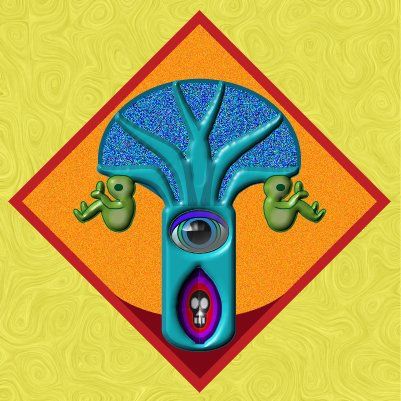
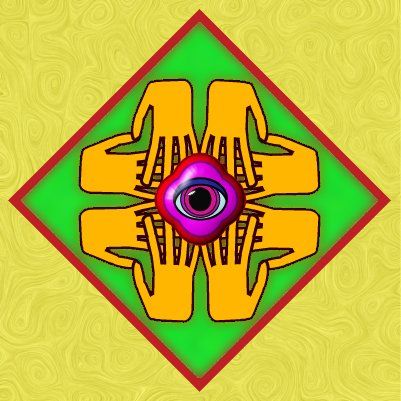
Keepers
While all goods within a cluster
belong to all circles, some specific, dangerous or precious items may be consigned to an individual circle. Specialized devices are entrusted to one or more masters of a given art within a circle. For example, Elders are bestowed with all Public Ceremonial Masks and are formally known as the ‘Keepers of the Artifacts’ as part of their charge of maintaining ‘Cluster Memory.’
Others, such as Maja, Betweens or other Spokes of the Cluster Wheel
who employ these articles, may also hold onto them as ‘Keepers.’ Some of these specialized items are on or around the Cluster Pillar or one or more of the four cluster gates. They may also be on a stand, mounted on a wall, or be put away only to emerge as needed.
Rare historical items, such as Culsu Medallions, are entrusted to a designated Elder Keeper within the Leadership Ring
and are only displayed on significant occasions. Single or groups of Betweens of any circle may be responsible for a certain number of the cluster’s House Masks. Usually, these remain out for use, but they are expected to attend, clean and repair them. When needed, they either fashion new or additional House Masks or oversee the work of others. When an item is deemed beyond repair or otherwise finished in its use to the cluster, most rural and urban Daman Yeldic
clusters are known to offer these items in a ceremony known as ‘Hungry Oblations’ to a nearby pool of Hungry Rock.
Keepers icon
This has been unchanged since the Primary Epoch and is enclosed within the ‘Primary Epoch Square.’ It depicts four sets of hands protecting a jewel with an eye centre. This is meant to symbolize any item that has memory bestowing dignity on present-day action.
Cluster-Of-Clusters Property
This designation is for certain natural features, plants, plants/animals and animals within a rural setting, along with fashioned public works in urban environments. For example, once established, a Ketukku
insect colony may not be disturbed. The land around the colony receives a Cluster-Of-Clusters
property designation, and some form of compensation, be it materials, goods or a new holding, is bestowed on the affected cluster. If a cluster discovers an emerging colony, they are permitted to petition for masters to come and relocate it. This may take place within the first year of the colony’s establishment.
Rural Cluster Creatures
Within Cluster Compound
Creatures dwelling within the cluster
compound as companions, servants, or specialized attendants have the same status as Healing Vats. While deemed cluster members, they do not participate to the same extent in cluster life. They are to be kept safe and secure and occasionally exchanged during Giftings
and divided between groups during Scent Separations. Cousin Touched
living within the cluster, or brought in as needed, allows for specific communication with these animals as required.
Outside Cluster Compound
All plant life within a cluster
territory naturally comes under the cluster’s possession. Those beings partaking of both plant and animal nature, particularly Bowvow Trees, are highly prized. As for wild animals, those deemed of particular value belong to the cluster if they nest within its land. They are trained and kept to serve the cluster’s needs where possible and desirable. Otherwise, depending on the creature's nature, the cluster’s behaviour towards them may range from leaving out appropriate food for them to disturbing them as little as possible. For example, Xumkuka
poles are set up over the cluster compound in the hopes one or more will choose to settle on them. This rewards the cluster by sweeping the area clean of blood midges and other pests and serves as a cultural benefit. When a known annoyance or menace encroaches, such as a Karthala
infestation, there are regulations on how to proceed. Violence is reserved for potentially edible creatures.
Other clusters may come to their assistance with dangerous or problematic animals as part of their reciprocity
arrangements. Some wild flora require exceptional ingenuity to share territory. A prime example is Thethelem. These near-flat and transparent odour feeders constantly seek ways into cluster compounds to feed on their accumulated aromas. Stench Traps
are placed around the compound, containing a small quantity of one of the most potent and unpleasant liquids known as ‘Yal’s Blood.’ Contained within the Tuntle Nut, they draw all Thethelem for extended periods. While living near a dead blood field is unpleasant, those clusters in proximity profit from producing and exporting
these Stench Traps.
Patzku
Patzku, one of the two ‘long-tail’ Cousins
primarily residing on the Skin of Anu instead of up in the trees, enjoys a distinct status. These Cousins were tailored throughout the Primary Epoch
to serve various uses in Rural Clusters. They can take on various specialized tasks with a small amount of initial training. Once instilled in the first generation, these skills are passed on by their dams to subsequent generations. As needed, these subsequent generations may receive further training. Remarkably, the Patzku has been known to improve on their training and demonstrably perfect many practices.
In general, the Patzku may be found maintaining food crops and distinguishing when blight is present, removing pests and protecting from larger predators. They maintain orchards and, to a high degree, gather ripe fruit. They have been known to distinguish where pruning and other maintenance is necessary.
Being of sufficient size and strength, they can manage livestock within their well-ordered troupes and engage in many necessary practices to ensure the safety and health of even large herds of animals.
Venerable Insect Societies exception
Gandahatapan
Venerable Insect Societies are a particular case. Should the mobile colonies of the aerial Gandahatapan, the ‘Perfection of the Air,’ settle on a tree or structure, they are left undisturbed, even during harvest. If their numbers threaten to undermine a construction or damage a nearby tree, clusters are called to assist in minimizing damage without disturbing the colony.
Beyond such fortifying actions, welcoming songs and dances are performed around the distinguished visitors at the outset of their stay, which usually extends for two to six two-weeks. Traditionally, being prodigious pollinators, they were welcomed in the spring, and if their location was beneficial, they were encouraged to extend their stay.
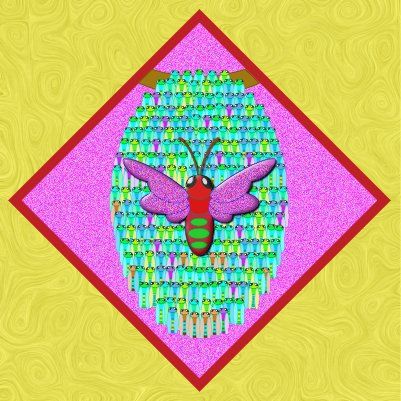
Gandahatapan and Mahakram
Clusters
know to keep a safe distance between these two natural adversaries, as they can have little or no contact with each other on large estates. Given the Gandahatapan’s nomadic nature, their presence is usually temporary, helping avoid clashes. Extensive lore exists to maintain the peace between these two civilizations, including landscaping and strategically placed barriers of a particular design to minimize contact.
If there is any sign of disturbance, elaborate measures and ingenious devices are employed to discourage groups of Gandahatapan from approaching the Mahakram's host tree. Perhaps the most dangerous and strange strategy involves another creature brought in to fight them. They may attempt to capture and set up several Sirintya
in a series of curved perimeters around the Mahakram tree if there is sufficient time. Given the toxin in their ‘chalices,’ this is undertaken only by those skilled to approach such a task. The Sirintya have an intense hostility for the Gandahatapan
and can capture and kill several at once. Despite being nocturnal, they are known to rouse themselves should they hear the whine of the Gandahatapan’s wings. None have determined why this antipathy exists between these two utterly unlike beings. These extreme measures are seldom employed because of the inherent danger in handling these creatures and the uncertainty of the results.
Nothing can be done on the rare occasions when, without warning, the Gandahatapan Queen sends her entire force against the Mahakram. This assault usually leads to the tree colony’s destruction and the cluster’s loss due to all other Mahakram colonies avoiding the battle zone for many years. The only clue of this immanent campaign is the Gandahatapan emitting a shrill whine not heard at any other time. During the battle, this reaches such a pitch that it is unbearable to hear. The aggressive steps to avoid this carnage when the Mahakram protects an orchard are detailed below.

Protection of Mahakram Arbours
With the introduction of Fecund Mahakram
Arbours, clusters
actively protect them from visiting Gandahatapan
colonies. A natural Gandahatapan colony has a range of two to four andas
around its hive. If they settle within two andas of a population of Mahakram Arbours, the cluster swiftly moves to dislodge and, if possible, relocate the Gandahatapan. Longstanding practices and tools exist to do this with surprisingly minimal disturbance to the nest. If the branch they are rooted to is gently cut at night when they are at rest, it is possible to move the entire colony to a new location.
Given their weight, a series of way stations are set up, and the nest is carried to each over several nights. Occasionally, isolating and gently removing the Queen is also possible. Her scent can then lead the rest to a new location.
Once she deems herself in no danger, she contentedly allows herself to be carried as her children quickly begin to follow her. There are signs this disposition was engendered long ago within the Living System of Tatchlan.
Of necessity, such relocations end before the first light. In such a rare instance where these strategies fail, the cluster defends their Mahakram Arbours by all means, including the regrettable destruction of the Gandahatapan. The only safe way to do this is to attack it by fire the night before their intended battle when their military whine usually warns of their impending offensive. There are very few recorded instances where this extreme measure was necessary.
Raw Mahakram colonies settling on a cluster tree are usually left in peace except in unusual circumstances where their presence disturbs some other aspect of cluster life.
Raw Mahakram and the Yakku
These colonies form a Perfection Symbol for the Yakku
and are integrated into Yakku mythology
and iconography. Given the Mahakram’s association with the Yakku, it is not uncommon for a Yeldic
cluster
to have Tellings
of Yakku
tales and Yakku dramas enacted nearby or surrounding a Mahakram-enhanced tree.
See Mahakram colonies within Fecund Farms
and Fecund Mahakram
below.
Instituting Ketukku Kingdom
If a Ketukku
colony becomes established on the land, a wide swath of cluster territory is cleared, including removing any food crops or replanting orchards to allow them to found their kingdom. A minimum of one anda
extends from the primary tower in all directions. This may involve neighbouring clusters, making this a joint venture, always overseen by the Cycles Ministry, as it impacts one or more cluster’s food and other goods production. Beneficial flora are planted and maintained, and specific foodstuffs are presented to the little kingdom on certain holidays, varying from region to region.
When a new colony establishes itself within an existing Ketukku Realm, the cluster attends to the following wonder. Due to their revered age, these insects manifest many signs of deep wisdom. One way this is displayed is by what is known as ‘Ketukku Peaceable Relations,’ where a colony becomes aware of another Ketukku colony within their territory.
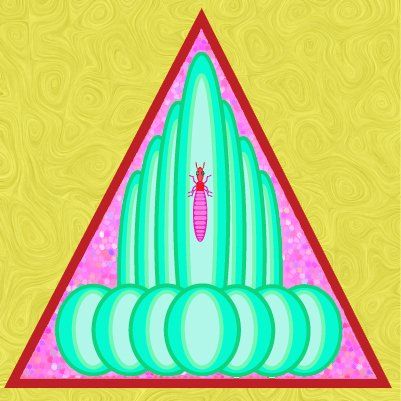
The response to this development is to withdraw their Soldiers and send out Scouts to determine the eldest. Once known, the younger colony begins to disassemble their towers and migrate to a new location. If a suitable site exists within the cluster’s lands, they may gently guide the colony to a particular setting. If they choose not to follow their direction and strike out for an area outside the cluster’s possessions, neighbouring clusters are alerted to the boon approaching them. They then take on encouraging and welcoming the honoured Ketukku to their lands. It is customary to formalize this ceremonial bestowal at a Gifting
between the clusters at a later date.
The term ‘Elder First, younger last’ appears to date from the prehistoric Mound Worshipers
witnessing what for them was the miraculous sight of the Ketukku’s elaborate measures to avoid conflict between colonies. As the saying goes, ‘Even Perfection may stumble,’ this is usually a flawless process between two or more Ketukku nations, on rare occasions, encountering difficulties. During these instances, the affected cluster or clusters may petition the Provincial Cycles Ministry
and even the Submissively Venerating
of their province for a large-scale relocation of the colonies to distant locations.
Four Yeldic Gateways
Ancient rural tradition
This rural Yeldic tradition
dates back to the ‘Field Yelda’ clusters of 10,623 UKC
on the Marachla Plain
of Rho-Jashun
when Koru Majastas
Complete
Lotmah VII noted this among many other collective cultural innovations. Even when temporarily relocated inside Ronthum 45 Living Mountain, they maintained the four gates in their clusters. These four gates open within large rural clusters’ walls at the cardinal points and are now given titles and specific duties. While some of this Field Yelda population remained on Rho-Jashun, most travelled to Upata-Shepsus
in 48,558 UKC during their Ceremonial Walk
to find the Danam Yeldic
civilization. This is detailed in the third novel of this series, ‘Dalinantu Emergence.’ Within Upata-Shepsus and all Danam Provincial Centres across Statos-Vey, these traditions were extended to the arrangement of the Majastas Court, and cardinal alignment became an integral part of court observance. By, or above, one of the gates described below stands one of the twenty-one plaques awarded to the cluster each year from the annual census. These plaques signify the
Cluster's Grade.
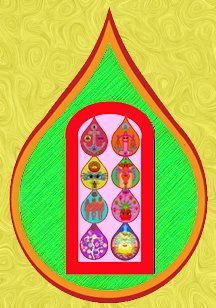
Southern Gateway
Called by many names, including the ‘Noble Gate’ and the ‘Anu
Gate,' this was the way unique visitors would enter and leave the cluster. All ceremonial events begin and end at this gate. Traditionally, the rural cluster’s Shesha
and Nara live outside this gateway, and its Healing Vats
are set up in niches on either side.
This and subsequent emblems of the four gateways were painted initially or otherwise presented on the four rural cluster doors. The design for each is the same on the inside and outside. What is shown here are emblems based on those ancient designs. They retain their door shape, but the seam of the two halves of the original doorways is gone, emphasizing the design. They now appear as emblems attached to the appropriate portal and in other settings. In this case, the Noble Gate presents the Eight Spokes of the Cluster Wheel, declaring the cluster in true harmony with the Cluster-of-Clusters Nation.
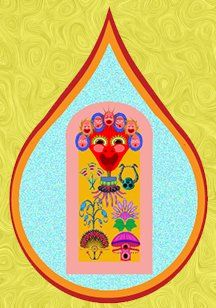
Eastern Gateway
A great many names hang on this gate. The most common was the ‘Gate of Delight’ and the ‘Open Mouth.’ The cluster
traditionally looks towards this gate if it has a central Pillar
with a face or eye. This is how entire guest clusters would enter and leave during Giftings
and other happy events. Each birth occurs close to this gate when possible, and favourable announcements are made here. Outside the Gate of Delight, certain specialized crops are grown for Circle Dances and other events requiring Vision Windows
or to enhance joy and fertility.
Aroma Touched of the cluster, or a guest cluster, may read a great deal about the state of the cluster by sampling this Scent Wall and determining the proportions and mix of the various Aroma Accords. Having these Accords displayed on the Eastern Gateway symbolizes the cluster is open to reading by all. Also present in the traditional design are the most-ancient musical instruments, the Dramsus
and the Haklu, signifying the epitome of culture and refinement.
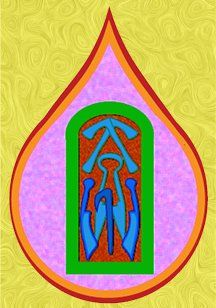
Western Gateway
It is known as the ‘Gate of Uses.’ This is the main gate for all traffic in and out of the cluster
to work on the land, tend the crops and orchards, cluster food animals and perform the many tasks associated with rural cluster life. Known as the ‘first gate,’ this designation was the first to be formalized, with the other three following later.
All these emblems were fashioned by the predecessors of the Danam Yelda, back when all Yelda
occupied the Marachla Plain
on Rho-Jashun. As an agrarian cluster of clusters, what was generally known as ‘Field Yelda’ employed the rural calendar images symbolizing standard tools used throughout the agricultural year into this gate.
After most migrated to Statos-Vey, the Danam Yelda honoured their ancestors by bringing forward these emblems as universal symbols of all uses and employed them in modern times throughout the Cluster-of-Clusters Nation, including to designate the stations for the Majastas Court.

Northern Gateway
This is known as the ‘Gate of Sorrows.’ After early manifestations of Nu’s Burning Blossom, it also was named ‘Nu’s Gate.’ The announcement of losses takes place here, and circles are summoned to it by the Elders
to receive hard news. Whenever illness strikes the cluster, its entrance displays the warnings.
The North Gate is where testaments and mementoes stand when a death occurs. When a Spoke of the Cluster Wheel
or an Elder dies, their memorial is raised here, and this is the one gate opened for anyone to enter or leave. When tragedy strikes, this is the sole entrance and exit to the cluster. Bodies are taken out of this gate for their planting in Anu.
Two symbols stand against a backdrop of parched soil. Below is the symbol of death, and above is the most-ancient character of The Common Desire. It was unusual for the Field Yelda
to use such deep iconography in their dwellings, particularly one with such complex meanings.
Principal and Secondary Crops
Blood Crop
‘Blood Crop’ refers primarily to Salarish, Charsha and related cereals and the use of blood in various stages of their cultivation. These crops are staples throughout Anu. The elaborate culture surrounding their planting and harvesting dates back to pre-Tatchlan
times. However, their present form came about during the later Unified
periods of The Lesser Era
of the Primary Epoch. According to their qualities, Salarish foods tend to be bland and Charsha spicier. There is a common saying: ‘Salarish mornings and Charsha evenings.‘
Temperate Crop
Salarish
is the first crop of the temperate zones of Anu. Growing in open, flat stretches of land under normal conditions, it progresses at a predictable rate. Its cultivation results in various flatbreads and cakes used as the basis for many traditional meals. Many customs exist around the growing of Salarish, none better known than the ‘Baby Mother’ rites, one of the oldest continually observed series of rituals known. See Salarish
for the history of this grain under the Buyanupithar Dynasty. Widespread cultivation of Charsha far predates Salarish, but due to its ability of Salarish to thrive in various conditions, it is now the primary staple crop of Anu.
Tropical Crop
Charsha
is the eldest of the two foundational staples and the tropics' base crop. It received continental-wide cultivation under the Funomanru Dynasty. Many specialized hybrids can grow in various conditions and altitudes as long as a plentiful water supply is available. It is also the earliest of the two primary crops of Anu. See Charsha for the history of its cultivation. The harvested grains are a staple for various dishes throughout Anu. These dishes tend to be more intense and aromatic than Salarish-based food because one of the qualities of Charsha is its ability to moderate and control the spicy or sweet foods eaten with it. A most-ancient tradition exists in planting this crop, known as the Sprouting Mother.
Baby Mother Harvest Traditions
In most-ancient times, long before the first Suvuka Onslaught
or the rise of Tatchlan, the Venerable Tolku
adored the soil, calling it the ‘Living Loam.’ With the commencement of large-scale field agriculture with the unifying dynasties, traditions began to ‘compensate’ Anu
for damaging Her Face across such a wide area. The cultivator's blood replenishes Her torn skin. Mostly, this took the form of modest bloodletting on the soil about to be ploughed or during ploughing.
Beyond this, many traditions ranging from a single offering of a few drops of blood to complete sacrifices continued. This has led to the general term ‘Blood Crop’ for all field cultivation. This was never the case for other forms of cultivation, i.e., orchards (see Fecund Farms
below). A wide variety of Harvest traditions exist for bringing in these Blood Crops, particularly those surrounding the ‘Baby Mother,’ some also involve bloodletting, and some do not. Many religions arose and became closely associated with various traditions; these ceremonial observances often continued after the founding myths had ceased to play a role in the community.

Cultivating types of plants that live on after gathering their fruits was generally preferred. Because of this, root foods were rarely cultivated. Most of those used have a single-season life.
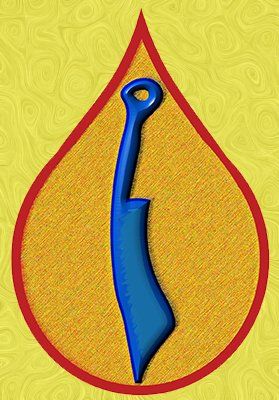
Kothon
This is the name of all versions of the traditional tool for ‘cutting’ into ‘Anu’s Face’ to spread the Blood Crop. In many places, this same tool, or depending on its specific design, a spur on it, is also used to make the blood offerings. It was also known as ‘Anu’s Sword’ and, like the soldier, the farmer would give names to their Kothon and pass them through generations with a grand ceremony. Often, large modern Kothon has smaller originals, or replicas of the ancient Anu Swords, attached to them. The name of the ancient Kothon is displayed prominently with the venerated item. Many songs and dramas celebrate the link between the farmer and the soldier.
It is to be noted that this ancient symbol has two different meanings. When pointing downward, it refers to the traditions detailed here. When pointed upward, it symbolizes the Commandant Ministry
and its attendant bureaus.
Salarish
is the staple blood crop used to make flat cakes, the foundation of many meals. Salarish crops fare better in temperate climates, such as southern Statos-Vey, central and northern Rho-Jashun, during the Greater Era
of the Primary Epoch and again in the Secondary Epoch, on central Thermistal on the vast Lake Teval
basin.
Salarish ‘Baby Mother’ Harvest
Various rituals accompany the harvesting of Salarish, centring on a figure called the Baby Mother. The far older Charsha Sprouting Mother image influences this Icon. The first mature grains of the crop are gathered, pounded and fermented with distinctive ingredients, including a drop of blood from Elders, Maja
and other Spokes of the Cluster’s Wheel. The resulting dough is formed into a small figure, dressed in bright colours and put on luxurious bedding. This Salarish Baby has two lights burning at its head and feet day and night.
They often have two small Life Pillars or flanking the lights on each side. The Baby’s bedding is always placed on a high platform, covered in abundant greenery and flowers or a traditional weaving or other covering designated for this purpose and surrounded by various deep baskets. These baskets are gradually added to what comes to be known as the ‘Baby Seed.’
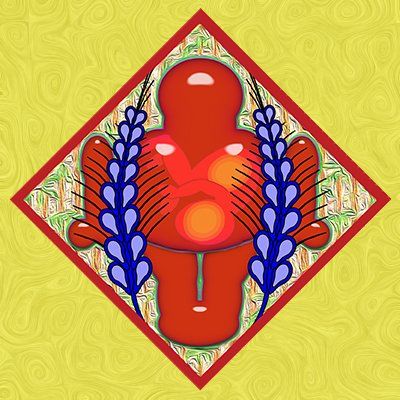
These seeds are grains judged the finest crop and reserved for next year’s planting. When the baskets are full, others replace them until the required amount is set aside. Occasionally, a new baby has to be fashioned if there is a delay in gathering the grains for the baskets. Only after these baskets are stored are preparations begun for the actual harvest. Depending on the size of the crop, up to ten times as many grains as were used for the Baby figure are now gathered and again fermented and formed into a dough.
The Salarish Baby is taken and dipped in a sweet resin before fresh dough is formed into an explicitly fertile female figure, now carrying the baby within her as a mother. The baby’s head points downward to ensure ‘delivery.’ The Salarish Mother is not dressed; instead, she is coated in the same edible resin and thus is prepared for her sacrifice. Several Life Pillars are also fashioned out of more dough and coated before they join her. The glistening Salarish Baby Mother and many Life Pillars are placed on a cart or carried on a palanquin along with preserved ears of Salarish from last year’s crop. They are pulled or carried by the cluster’s Elders
around the fields. With song and ceremony, the entire cluster accompanies her. Fermented Sap sprays her, the pillars, and all the participants as part of the ceremony.
From this point, traditions vary widely. They might proceed to the centre of a field, in some way designated to stand for all the others, where she and the pillars are disrobed and torn apart. The pieces are flung in the air, and community members catch and eat what they can. The Baby Mother and her Pillars might finish their circuit and return to the platform for later consumption as part of the harvest feast. Some communities living near large bodies of freshwater are known to take the Baby Mother from the fields and out onto their lake or river and submerge her. Water is brought and, with ceremony, spread on the fields. Whatever the form, this carrying of the Baby Mother and the Life Pillars around the areas signals the beginning of the harvest.
Black and Red ‘Baby Mother’ Harvest
In many parts of Anu, the Baby Mother ritual is repeated twice to harvest the Coarse and Fine Salarish. The Coarse or Black Salarish is sown in the fall, traditionally in Fall Six, and the crop rises first, while the Fine or Red Salarish is planted in the spring. The Coarse Salarish is harvested first, in early summer, traditionally during ‘Summer Three’ (see below). Fine Salarish is traditionally harvested one hundred days later, during ‘Summer Eight.’
Salarish Agricultural Calendar
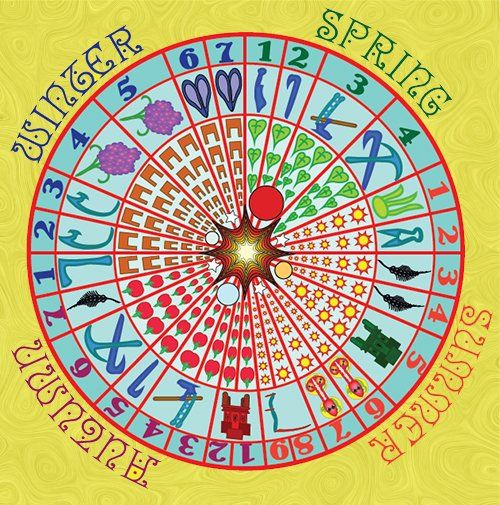
Calendar Wheel
What follows is used in the temperate zones (central-southern Rho-Jashun, southern Statos-Vey, the Lake Teval Basin
and portions of southern Thermistal), where Salarish
is primarily cultivated.
Growing conditions and other influences ensure this calendar can only be approximated during any growing season. Many local rituals and traditions are not mentioned here due to their association with a particular region.
This is a traditional Salarish Calendar Wheel, outlining, in general, the activities taking place during the Spring, Summer, Autumn and Winter Seasons.
These calendars are commonly found filling a wall of rural Ablution Academies. There is a dial at the centre with an arrow pointing to the current two-week
of the agricultural year. Beneath the numeral for each two-week are symbols associated with events of this time of year. This circle contains ornamental icons symbolizing each season established during the Pre-Tatchlan
period.
The single leaf represents the Spring Season, the ‘Star Flower’ the Summer Season and the Ripe Fruit the Autumn Season. The Winter Season is characterized by what may be interpreted as a wooden bench or shelter, signifying the construction and other work during the winter. The most-ancient images of Nu
and the four moons are at the heart of the calendar circle. These are based on the Lesser Era
images from the Chelyakan Religion, which venerated pastoral and rural life.
Beginning of Spring Season
Taking out of the winter manure stores and spreading before ploughing spring fields. The hardest seeds able to withstand late frost are planted first. Creating sheltered seedbeds for late-planting seed and weeding fall-planted areas.
Spring One
Two-Week
Five:
Title: “Berat” – Mask
Symbol: Mask
Day 73 to Day 90
Salt piles left by the Dry Vilates the previous Autumn are removed from the loam before the first rains. This process may occur in Winter Seven or Six if the rains come early. If they arrive before the salt is harvested, planting goes ahead, and the salt is harvested among the seedlings.
Kothon Festival
Farmers wear armour and wield their Kothon’s in mock battle during the Kothon Festival before planting, symbolizing their intention to cut into Anu’s Face. Blood poured out in the fields as compensation for injuring Anu’s Face with the plough. The resulting produce is known as the ‘Blood Crop.’

Spring Two
Two-Week Six:
Title: “Tret” – Torches, candles
Symbol: Collection of torches and candles
Day 91 to Day 108
Spring Three
Two-Week Seven:
Title: “Kritta” – Body
Symbol: Body with arms and legs stretched out
Day 109 to Day 126
During this time, intensive hoeing of the crops takes place to keep weeds back throughout the fields.
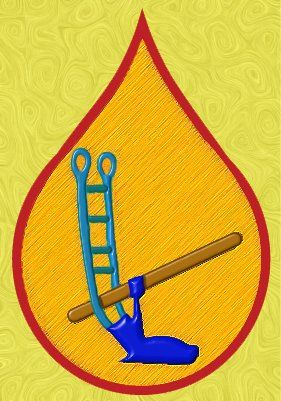
Spring Four
Two-Week Eight:
Title: “Kalom” – Hear
Symbol: Ear
Day 127 to Day 144
Also known as the Two-Week
of Perfection, it is the tradition to begin new ventures and conclude old ones during this period.
Beginning of Summer Season
The harvesting and airing of feed grasses for winter fodder begin with sheering and plucking excess fleece.
Summer One
Two-Week Nine:
Title: “Darilda” – Sweet
Symbol: Burning incense sticks
Day 145 to Day 162
Summer Two
Two-Week Ten:
Title: “Paultesh” – Reflect
Symbol: Seated figure
Day 163 to Day 180
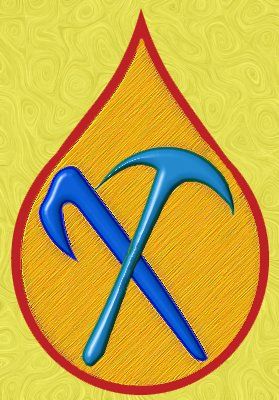
Summer Three
Two-Week Eleven:
Title: “Unna” – Mountain
Symbol: Mountain
Day 181 to Day 198
Harvesting of the fall crop of Coarse Salarish
begins.
See Black Baby Mother Harvest Ritual
Summer Four
Two-Week Twelve:
Title: “Xoyya” – Ship
Symbol: Highly decorated ship
Day 199 to Day 216
Coarse Salarish is gathered in ceremony into Salarish Houses
set on pillars off the ground for drying.
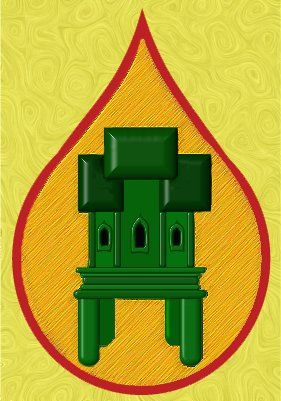
Summer Five
Two-Week Thirteen:
Title: “Rakal” – Basket
Symbol: Woven basket
Day 217 to Day 234
Days 229 and 230 MIDYEAR
Summer Six
Two-Week Fourteen:
Title: “Min” – Banner
Symbol: Ceremonial banner
Day 235 to Day 252
Mid-summer fertility festivals celebrate the beginning of the breeding season for most herds so their young are born in time for spring when new feed will be plentiful.
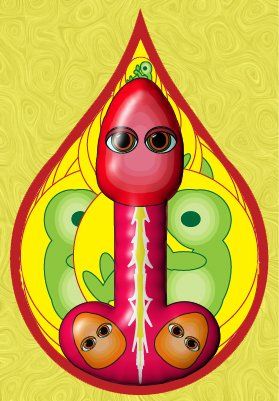
Summer Seven
Two-Week Fifteen:
Title: “Vin” – Fish
Symbol: Fish
Day 253 to Day 270
Summer Eight
Summer Eight
Two-Week Sixteen:
Title: “Jixx” – Beauty
Symbol: Beautiful face
Day 271 to Day 288
Also known as the Two-Week
of ‘Double Perfection.’ Like Two-Week Eight, Kalom, this is an auspicious time to begin new ventures. Fine Salarish sown harvest starts in the spring, followed by all other crops. Harvesting other ripened crops, such as from orchards and raw
growth, occurs.
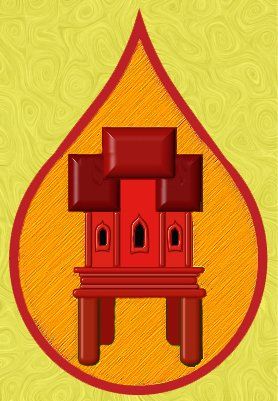
Summer Nine
Two-Week Seventeen:
Title: “Zah” – Wisdom
Symbol: Books
Day 289 to Day 306
Fine Salarish are gathered into their Houses to dry. The traditional farming year ends with these events.
Beginning of Autumn Season
Wakas marks the traditional beginning of the farming year. Manuring is followed by autumn ploughing, and autumn seed planting for Coarse Salarish begins. The planting seed from the previous crop that had been set aside and dried in their houses for six two-weeks
is now brought out. Culling, the provision for domestic herd feed for the coming winter and other maintenance begins.
Autumn Season One
Two-Week Eighteen:
Title: “Wakas” – City
Symbol: Buildings
Day 307 to Day 324
Every ten years, new infusions of Dry Vilates
are sown over the harvested fields to begin drawing up excess minerals from the soil.
Autumn Two
Two-Week Nineteen:
Title: “Ocan” – Jewels
Symbol: Jewellery
Day 325 to Day 342
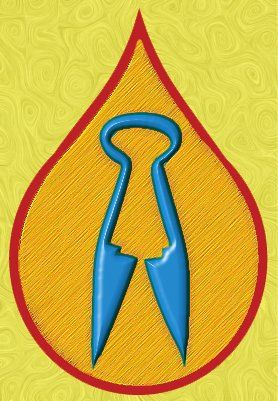
Autumn Three
Two-Week Twenty:
Title: “Dolmel” – Hand
Symbol: Hands
Day 343 to Day 360
Autumn Four
Two-Week Twenty-One:
Title: “Andura” – Ocean
Symbol: Ocean
Day 361 to Day 378

Autumn Five
Two-Week Twenty-Two:
Title: “Dimelad” – Flute
Symbol: Flutes
Day 379 to Day 396
Autumn Six
Two-Week Twenty-Three:
Title: “Thil” – Foot
Symbol: Feet
Day 397 to Day 414
Coarse or Black Salarish
is sown to begin growing, then goes dormant over the winter only to resurge in the spring and be harvested on or near Summer Three.

Autumn Seven
Two-Week Twenty-Four:
Title: “Drostol” – Lamp
Symbol: Ornate Lamp
Day 415 to Day 432
Also known as the Two-Week
of ‘Triple Perfection.’ It has the same traditions as Two-Week Eight and Sixteen.
Beginning of Winter Season
Ploughing completed of existing and new fields to allow frost to break down soil for spring cultivation. Black Salarish crops are established and begin to go dormant for the winter. Woodland cutting, the maintenance of herd fencing, and the provision of the following winter’s fuel attended to.
Daily provision of water to herds and major and minor repairs to all structures and tools are done at this time. The Fine or Red Salarish that has been dried through the season is now broken down to naked seed for spring planting. This is also the time to harvest many crops from the Fecund Farms. The Grape Harvest has many ecstatic celebrations.
Winter One
Two-Week Twenty-Five:
Title: “Crissa” – Four Moons
Symbol: Four Moons
Day 433 to Day 450
Winter Two
Two-Week Twenty-Six:
Title: “Kavuk” – Fertility
Symbol: Life Pillar
with Eye or Face
Day 451 to 468
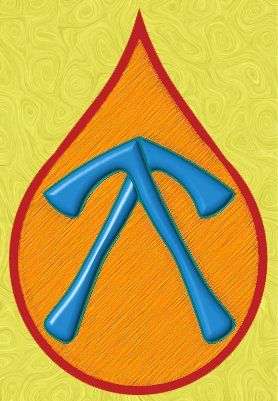
Winter Three
Two-Week Twenty-Seven:
Title: “Alatahanu” – Twelve Faces
Symbol: Twelve Faces in Wheel formation
Day 469 to 486
Winter Four
Two-Week One:
Title: “Atra” - Bursting Flame
Symbol: Star or Flame
Day One to Day 18
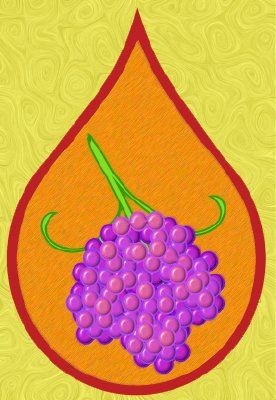
Winter Five
Two-Week Two:
Title: “Deel” – Trick
Symbol: Trickster in makeup
Day 19 to Day 36
Winter Six
Title: “Topy” – Needle
Symbol: Needle piercing cloth
Day 37 to Day 54
Winter Seven
Two-Week Four:
Title: “Ingeen” - Wheel
Symbol: Wheel
Day 55 to Day 72
Charsha
Staple
Charsha
is the staple blood crop of long-fat grains cooked and served with many dishes. Charsha does better in wet, tropical environments, such as central and northern Statos-Vey
and southern Rho-Jashun. There is an elaborate process of germination and initial planting of seedlings, followed by re-planting into saturated beds in various settings. Charsha is the elder of the two staple crops but is more restricted in its range, challenging, and labour-intensive to cultivate.
Charsha calendar varies
Unlike Salarish, which spreads across vast swaths of the temperate Marachla Plain
on Rho-Jashun
and the fertile open fields of southern Statos-Vey, and the rich loam around the Lake Teval Basin, Charsha grows in a wide variety of tropical settings at different altitudes, including within elaborate terrace systems climbing the slopes of many mountains in the Veredapandra
range. This means there is no one calendar for planting, cultivating and harvesting, which often takes place two or three times a year, depending on local customs and conditions.
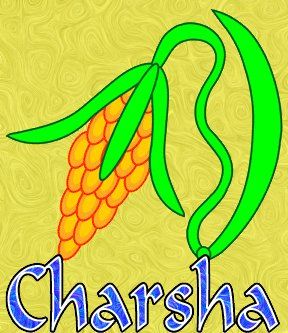
Charsha Crop’s pregnancy
After the flower, which is known for its distinctive fragrance, Charsha begins to form fruit. When top leaves form and curl inward to shelter the fruit, the crop is said to be pregnant. As the plants were all germinated, planted, and then transplanted at once, this pregnancy manifests throughout the crop. The entire community goes into the fields, stroking and tending each plant as they would pamper a pregnant woman. Small offerings made of various traditional remedies are applied throughout the area for the attendant ills associated with pregnancy. The Sprouting Mother (see immediately below) is now in her palace.
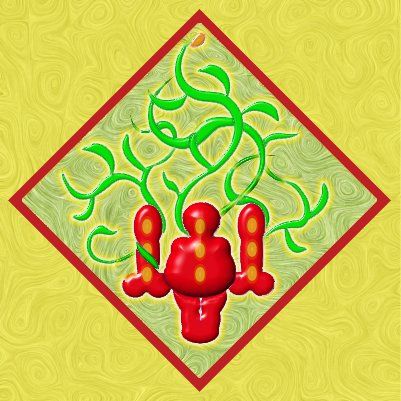
Charsha Sprouting Mother
As with the Baby Mother traditions surrounding the harvesting of Salarish, there is something similar for when the Charsha crop is deemed pregnant. At the harvest in the previous season, the seed Charsha is separated from the various other types of Charsha used for specific types of cooking and set aside for the next planting. These are light, medium and heavy Charsha, sticky Charsha and dry Charsha.
Other varieties are distinguished by the size or colour of their kernel and distinctive flavours. A small part of this seed, combined with sticky Charsha, is fermented and rendered into a thick mass, forming a series of small images of pregnant women and Life Pillars.
They are all brightly coloured, dressed and wrapped in Chitazan Leaves, well suited to ensuring they only harden the next season and put in an ornate container with the stored Charsha.
When planting time comes for this seed, called Mother Charsha, it is soaked for days to germinate. The Charsha Mother figures and the Life Pillars are opened. They are fertilized by a hybrid version of Charsha seed placed inside them, along with a small amount of blood from several community members chosen in various ways. They are wrapped and soaked for as long as the rest of the Mother Seed and then coloured and dressed again. Small platforms rise on the edge of each field. A tiny palace is then created and painted, containing a high chair for each Mother figure to sit on. There are usually four to eight Life Pillars placed around her to provide additional fertility. This palace is positioned at the back of the platform, leaving space for offerings in front of it. Over time, the hybrid seed sprouts and grows inside the figures. The new plant's roots spread throughout the formation, and soon, brightly coloured nodes and then leaves emerge from the top. The palace is removed at this time, and the growing figures are exposed to the air. If possible, their robes are removed. The exposure of these figures declares to all around the field they stand over is pregnant, and only those directly associated with it may enter.
Second Planting due to pests
Due to its more tropical venue, Charsha is far more subject to devastating pests than Salarish. The Soltana Worm and the Warbsa Beetle come early in the planting, usually before the crop becomes pregnant. These water creatures infrequently appear in both cases, usually between three to five years between infestations. The community’s chief defence is the Teer Beetle.
Offering to creatures after harvest
An elaborate effort is expended throughout the growing season to keep all creatures away from the crop. Once the harvest is in, a small portion of the crop is brought out and cast over the now barren fields as a peace offering to those creatures unable to consume the produce while standing.
Dimensions of successful crop
A season is said to be bountiful when the harvest is fifty times the size of the original planting.
Fecund Farms
While the customs described below may range throughout Anu, they are more pronounced and relatively uniform immediately north and south of the Pax Zenam Ridge, on southern Rho-Jashun
and northern and central Statos-Vey.
Fertility
rites
Unlike Blood Crops
planted in broad fields or terraced hillsides, most other forms of agriculture do not have bloodletting ceremonies attached to them. A very different set of practices grew around the notion of Anu
being impregnated by the seed, bearing the food and giving birth to the harvest. This was linked to plants having an extended life and producing many crops over time. The planting and cultivation of these were tied to symbols of fertility. The area is gently prepared ahead of time as if to woo Anu. The many living creatures inhabiting the area are fed and removed with care. Sweet waters sprinkle the grove and ground around it. The branches of the pre-budding plants are festooned with colourful streamers to assist in ‘waking’ them. The rites at the first bud or planting and harvest are ecstatic. Traditionally, a conception or birth among the groves is seen as most fortunate for mother and child. Unlike the Blood Crop’s tools resembling weapons, the means employed on Fecund Farms are fashioned to overtly symbolize sexuality, birth and pre-adulthood, depending on when in the cycle of the plant they were used.
Death Feeding Life
Linked to these evocations of fertility, there was an equal emphasis on death feeding life. The common practice involved bringing a portion of the dead, both Tolku
and other animals, along with all defecations of the community. These would be spread or buried with some ceremony at the beginning of the season and throughout the year or fed to Bowvow Trees
planted around the periphery and at the heart of orchards. Over time, the Bowvow’s digestion of body offerings spread through the soil to benefit the orchard.
Three customs are nearly universal: the Blossom Silence, the Monthly Courses Round, and the Egg Planting.
Blossom Silence
This simple observance involves those clusters living near groves coming into blossom, speaking in whispers for the first two-week of the season. This is to allow the trees or vines peace to enjoy their intimacies with the various insects visiting them and to prepare for their transformation into fruit.
Monthly Courses Round
The Monthly Courses Round involves women of all ages going to groves and vineyards during their monthly flow and walking around each plant while running their hands over the trunks and branches. Most of these traditions also involved spending short periods inside Bowvow Trees
attached to the grove. There, they spread some of their blood to the inner walls of the Bowvow to enrich the surrounding fruit further. Some regions see the practice of vertical smearing to encourage local insect predators to mass up the trunks and purge all pests affecting the tree.
Egg Planting
Another common custom the community women perform is finding or fashioning stones, wood or other objects resembling an egg. They are to lie with it for a month and then take it, often during their Monthly Courses Round (above). They select a tree and find a place to set or attach their egg to impart their fertility to the tree. They may lash it with woven grasses and twigs but nothing more. Over time, some of these become part of the tree as it grows around them, leading to ancient orchards having trunks filled with egg forms. If, despite its fastenings, the egg falls out, the ancients interpreted this as the tree expelling it from its body. It is placed at the tree's base and not set on it again. A variation of this custom further north and south involves eggs made out of Salarish
dough. Such eggs may, for a short time, be put on the tree but are usually fed in time to the Bowvow Trees
within the orchard.
Mahakram colonies within Fecund Farms
Late in the Funomanru Dynasty of the Lesser Era
of the Primary Epoch, the Tolku
perfected various crafts to harness the protective powers of the Mahakram, known as the ’Yellow Cloud.’ These tiny predatory spider colonies encircle a tree in layers of netting which trap any insect, even something as significant as small animals, becoming entangled in them while not harming the tree. These most-ancient farming clusters
came to seed these colonies amongst their fruit orchards to protect their fruit, which were prone to many pests and devised numerous ways to gather the fruit at harvest time safely.
This elaborate Icon
dates from early in the Primary Epoch
and shows a favoured image among rural clusters Tolku and Yelda of their orchard’s leaves and fruit covered by members of the sizeable Mahakram spider community. This symbolized health and prosperity due to the Mahakram’s protection. One indicator of the early date of this image is that Nu
appears as a beneficial agency shining down from above.
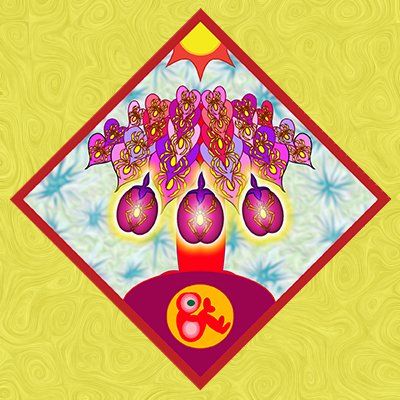
The infant buried beneath the orchard refers to the most-ancient practice of burying stillbirths beneath orchards with other rites associated with fertility performed at Fecund Farms.
Fecund Mahakram
A new Secondary Epoch
branch of Mahakram was fashioned within the Tatchlan System
during the reign of Danam Yeldic
Majastas
Horm Unu VIII. Fecund Mahakram only settles on fruit trees. They begin to establish their webbed world at the trunk, allowing the flowers to be pollinated. Later, they changed their nest architecture to accommodate growing fruit and created openings at the bottom to enable their harvesting. Rural clusters begin to leave one tree free of Mahakram to allow infestations for more considerable life benefits. In the year 66,794 UKC
and 18,075 of the Nantu Calendar, this fully perfected strain is introduced across Statos-Vey
to protect fruit crops before being exported to other portions of Anu.
Mahakram Arbours
This further refinement was introduced simultaneously as the Fecund Mahakram, specifically for protecting Grape Arbours. During harvest, generally between Winter Four and Five, there are many rapturous ceremonies, including gently ‘folding’ the Mahakram Nest edges to allow for a complete harvest.
Fishery Craft
Abundance of fresh water on Statos-Vey
Fishery Craft is a refined set of practices on Statos-Vey, where there is an abundance of rivers, lakes, streams, and brooks, along with a proliferation of underground channels producing innumerable deep ponds. This subcontinent is continually washed by the vapours from the Panchala Sea, flowing in curtains over portions of the low Veradapandra Mountain Chain westward to feed the subcontinent's enviable water table. With the Funomanru Dynasty
in the Pre-Tatchlan
era, this abundant moisture was extensively augmented by canal systems across the subcontinent to form a transportation network and a vast fish farming landscape. These natural and artful elements were augmented by a mounting sophistication in how hydraulic forces could circulate water in enclosed spaces with precision.
Tatchlan fish perfection
With the advent of Tatchlan
during the Primary Epoch, Fishery Arts began with a far greater degree of controlled design. Specialized Invocates
located each species within the Living System of Tatchlan with exactness, and all subsequent generations were examined regularly for any signs of difficulty. Traditional predators, pests, and diseases are thwarted within the Living System in many ways. One strategy involved fortifying the fish to successfully fight off infections while evading or withstanding more extensive predator assaults. This more aggressive strategy involved a shift in their school formations in assuming attack postures and behaviour when threatened. Foes were converted into servants of their former prey by removing all desire for them while developing a taste for other predators less subject to modification.
All this allowed for the cultivation of various hybrid fish and other aquatic life tailored over many generations to serve as a staple food source, along with supportive swimming hierarchies attending to and protecting the primary fish schools. The fish now living in these cultivated environments are deeply crafted and specialized. The success of this generational effort is such that these fish are traditionally preferred by most living on Statos-Vey
to ‘raw
fish’ caught in open fresh or salt waters. However, they may serve as a garnish for crafted fish dishes.
Recovered Ones
The above description occurred during the Primary Epoch
within the Tolku
Cluster-of-Clusters
civilization. After the Killing Swath, the Second Suvuka Onslaught, like many other treasures, Fishery Craft appeared lost. Yet, early in the Secondary Epoch
(234 UKC), during the reign of the first Koru Majastas Zudaz-Vozev, small intact schools of Gelfion, Camalus, Nemain and Halahala Schools (see below) were rediscovered on portions of the Northwest Plains Region of Statos-Vey
and nurtured back to health. It was seen as a wonder that such highly specialized and seemingly vulnerable populations, with their attending secondary species, could survive violence and extended privation in near intact conditions. In the ages leading up to the Ceremonial Walk
of the Danam Yelda, a restoration of the entire canal and lake network of the Funomanru Dynasty
on Statos-Vey took place. It was stocked for them to inherit this vital food industry of Anu. They are all now of the first Rank of the Koru’s Recovered Ones, the ‘Converted.’
Statos-Vey Centre of Fishery Craft
As during the Primary Epoch, in the age of Koru
and Yelda,
in the Secondary Epoch, only small portions of southern Rho-Jashun, mainly south of the Mulungu Mountains, and in the far southwestern region of Danadejet may in part reproduce these ideal Fishery Craft conditions. They have never matched Central Statos-Vey
in their mastery of Fishery Arts. The revival of the Fishery Craft infrastructure across Statos-Vey to fuel the growth of the expanding Koru Living Mountain Districts and Dependencies
was the first stage of the long preparation of reclaiming the subcontinent for the eventual occupation by the Danam Yelda.
Fish Hierarchies
Gelfion
Largest and most docile
Also known as the Stately Gelfion, these are the largest and most docile of farmed fish. It is not uncommon for elder fish to not only allow themselves to be stroked by Yelda
but permit children to be placed on their backs and carried some distance through the waters. Their bodies are blue/green in colour with purple gills and red fins.
They live in schools of one to four hundred adult members. They inhabit large lakes with at least one canal or river attaching to a series of two or more additional bodies of water.
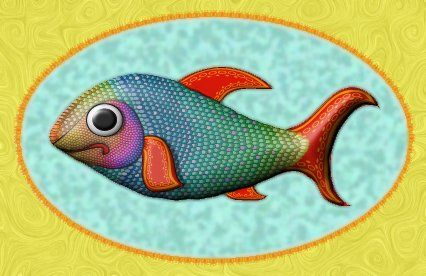
Their cycle involves seasonal circulation from one area to another. Typically, these lakes, ponds, streams and canals are built in a circular formation around the attending Yeldic cluster
or clusters. This formation may support two or more Gelfion schools, moving on opposite sides of this circular rotation of lakes and canals. Their flesh cures very well, preserving for long periods. Their oils are extracted simultaneously and shipped in distinctive jars with the cured flesh. The common practice is to pour this oil over the cured fish before preparations, leading to an intensified series of flavours deemed an improvement over fresh-caught fish. There is an extensive cured fish and oils trade throughout Anu.
Gelfion March
This ceremony is held twice a year. Most commence at the beginning of Two-Week
Twelve, ‘The Ship,’ (Summer Four) and again at the start of Two-Week Twenty-Seven, ‘The Twelve Faces’ (Winter Three). This is a procession by all cluster
mates around the residing lake of one of the Gelfion Schools playing distinctive wind instruments the Gelfion respond to. After one circuit of the lake, the cluster divides and goes either side of the canal or stream and progresses towards the adjoining lake; the Gelfion School responds by following them to their new residence. This lake is made clear before their arrival. If there are new schools, they will be in different lakes in the chain and will have a separate ceremony to relocate them. Clusters wear the Gelfion colours and various additional elements, which differ according to the cluster tradition and region. A portion of the Gelfion School is ready for harvesting at this time. These are tagged, separated from the others between the two lakes, and lifted out. When laid on their sides, their weight swiftly dispatches them. The bodies are then removed from the area, and care is taken that no blood enters the waterways. Large clusters with more than two schools may conduct this ceremony thrice a year.
Gelfion Servants
The Gelfion is attended by lesser fish, serpents and waterfowl designed to feed, clean and protect their master schools. Chief among those directly attending the Gelfion School are the Camalus (see below).
Four Circle Rating
An adult Gelfion fish is said to have a Four Circle Rating, meaning an average fish may feed four circles of eight
or thirty-two cluster mates. Their flesh is abundant and has a savoury quality.
Camalus
Once a predator
This is a bright yellow fish with notable mirror dorsal and anal fin formation that has two functions. It is an attendant to the much larger Gelfion
schools and a food fish in its own right.
Despite their size, the Camalus was once a predator of the Gelfion, known for massing in huge numbers, burrowing into the bodies of larger fish, and eating them from the inside out. Their upper and lower fin formations have spike spines, making it impossible to dislodge them once they begin burrowing.
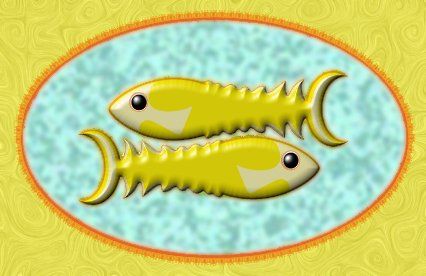
For their small size and their lethal organization, they are dubbed the ‘Mahakram
of the Waters.’ During the Primary Epoch, these fearsome predators were successfully adjusted to become the Gelfion’s guardian. They travel in a series of large schools around the large Gelfion School to ward off any potential predators. They do this by forming a unique pattern of sweeps travelling in opposite directions around the school. Although they do this with bursts of tremendous speed and seem to mingle with those travelling in the opposite direction, there are usually no collisions between them. When there is a collision, this is a sign one or more of the schools are ailing. Their emblem shows two fish travelling in opposite directions without touching each other.
Camalus Harvesting and Culling single Gelfion
Camalus are also fashioned to single out those ready for harvest between the Gelfion Marches by smelling when a fish has peaked. They surround the mature fish and conduct it towards repetitive splashing at the shore, where the giant beast is netted and swiftly brought out of the water before being dispatched and processed. The Camalus perform an extension of this service by culling the diseased and injured among the Gelfion. Vertum
abandons a host fish when it is ailing, which the Camalus immediately notes. It is said the achievement of the most-ancient Invocates
was to keep their original instincts intact to be triggered at the sight of Vertum leaving one or more members of the Gelfion School, along with any scent of illness or death, causing them to fall out of formation from the rest. The Gelfion School knows to abandon these potential threats to their fate.
Although in large Gelfion schools, there are always a few diseased fish, clusters monitor Camalus activity. They will bring in large prey fish and introduce them simultaneously on four sides of the host lake for them to feed on.
Camalus and Chupukam
Camalus is the one farmed fish that improves if not removed immediately from the water after death. Left at the surface for a few hours during the day, the carcass attracts Chupukam; infinitesimal beings are collectively known as the Rainbow Serpent (see below). In the initial consumption process, this vast herd of creatures enters and adds a series of chemicals which significantly improve the meat. It then can be removed and cleaned before fresh preparation or curing. Thus, fish changed before harvesting is termed ‘Chupukam Camalus’ and deemed more desirable.
Eight-to-One Circle Rating
A harvested adult Camalus fish is said to have an Eight-to-One Circle Rating, meaning an average fish may feed a single member of a circle of eight. Their flesh requires some preparation unless the Chupukam has fermented it before extraction. ‘Chupukam Camalus’ has a prized sweetness.
Nemain
Circular profile
This small fish is clothed in various dull green hues and swims alternately upright and on either side with a single large fin extending from the top and bottom of its body.
These fins have intricate lace patterning with numerous openings of various sizes, and taken together, they create a circular profile for the creature. This single fin is composed of muscle instead of the extended membrane and is an efficient means of propulsion and manoeuvring.
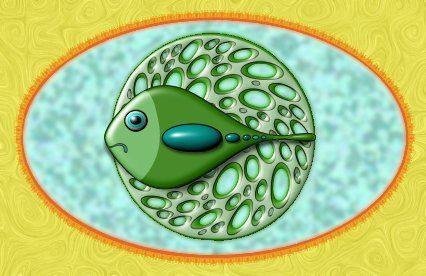
Oil highly prized
Its flesh is a delicacy, but it is highly prized for its oil, which it produces in exceptional quantities beneath five oval caps midway on either side of its body. When harvested and these caps removed, the inner side is covered in regular white bumps, indicating this creature has been modified within the Tatchlan System
to increase and enrich its oils. These oils have various therapeutic applications augmented within the Living System.
Morning Music
Just before dawn, it is possible to hear faint musical pings from just below the surface of the Nemain’s pools. This comes from the schools swimming in tight circles and their caps glancing off each other quickly. While impossible to be sure, it appears they desire to create this musical series, but only at this time of day.
Abuse of oil
During the time of machines, this oil was found to assist in their operation. Still, the demand for it led to corrupt practices with the creatures before the Yin-Vinulan Dynasty
of the Lesser Era
stopped their indiscriminate destruction. This modest being became the symbol of the campaign to eradicate all machines.
Small pools
The fish lives in small schools in solitary ponds with a spring-fed bottom. They do not mix with the other fish hierarchies. The accumulation of tiny emissions from their oil caps and other body sources makes water changes unsuitable for most other species living in their pools. The one exception is the Halahala (see below) due to their tolerating the changed water and occupying different portions of their pond. Each population continues with little or no contact with the other. This is a beneficial relationship for the Nemain as Pomale worms (see below) are also drawn to these dark waters. Halahala is one of their few predators, so they protect the Nemain schools.
Sixteen Circle Rating
Despite their small size, an adult Nemain fish is said to have a Sixteen Circle Rating, meaning the oil from one Nemain may benefit sixteen circles of eight
of one hundred and twenty-eight cluster mates.
Halahala
Walking Fish
This farmed fish is unique in living at the shoreline in and out of the water. Over many prehistoric Aeons, their fins grew bones. Their front fins became primitive arms, while their back fins grew wide, flat feet. Their tail, primarily employed for brief swimming offshore, may also aid in on-land movement. Their limbs flatten against their sides during swimming. Their eyes are enormous, rise above their heads and have a measure of activity, allowing them to negotiate both under and above water. They prefer muddy shores and are never more than a small jump from the water’s edge.

They come out in numbers during heavy rains. They are thick-set and rich in oil. They peacefully share their below-water realm with the otherwise aloof Nemain (see above) and their above-water territory with the stately Varox
(see below), which has no taste for them.
Small lakes and ponds
Despite dwelling in schools of sixty or more, they prefer living out their span in a single small lake or isolated still pond. They can thrive in ‘thick’ or otherwise unclear water, such as what is created by schools of Nemain Fish, mainly near the shoreline.
Halahala and Kamad
They have a symbiotic relationship with the Kamad worm, commonly called ‘Eye Fish,’ which lives in small colonies in their large eyes. These worms appear to modify their eyes in the open air to better see and maneuver out of the water. They also luminesce on the rare occasion that the Halahala dives deep into the lake or pool bottom. When they luminesce their eyes at the surface, the Halahala is ready for harvesting. Notably, this often occurs in many schools at once, and once luminescence begins, the Halahala grow sluggish and are quickly scooped up.
Halahala and Pomale
Another distinct relationship exists between this creature and a strange breed of worm known as the Pomale. This worm is toxic to all other farmed fish, and only a few rare animals prey on them in the wild. These worms also prefer still surfaces, naturally gravitating to the Halahala’s waters. The Halahala is unique among edible fish in being immune to their venom, and it is said their ingesting a quantity of these worms over their lifetimes adds unique qualities to their flesh and oil. This intake is monitored. Too high a concentration of Pomale in their diet may poison their attending Kamad or ‘Eye Fish’ and adversely affect the quality of their flesh.
Two Circle Rating
While less than half the size of an adult Gelfion, Halahala has a Two Circle Ranking, meaning an average creature may feed two circles of eight
or sixteen cluster mates. This ranking is primarily achieved by their abundance of oil, which enriches other aspects of a wide variety of traditional meals they serve with them. It is also achieved by a lifetime of eating the Pomale worm, which imbues their flesh and oil with distinctive flavours and qualities.
Jizo
Small bottom feeder
This small bottom feeder is employed for most farms and seldom occupies the waters simultaneously as the principal crop. Their job is to return the lake or other waterways to their previous state after an extended period of occupation by large populations of Gelfion
or other schools. Unlike all other occupants of Fishery Craft Farms, these are primarily ‘raw,’ which is unimproved by Tatchlan.
Serpents
Uzumal
These small brown water serpents perform a particular function. They moderate the temperature and quality of the waters by moving in energetic hoops, swimming to the surface and then to the depths in swirling circular formations. These small groups of Uzumal often move ahead of Gelfion
schools, forming a vortex of churned waters. The reason for their actions is to stir up the bottom and suck the tiny flora they eat out of their lake-bottom burrows. This activity brings many other feeders into the oncoming mouths of the Gelfion school, allows for mixing the warmer surface water with the chill depths, and disrupts the growth of certain potentially harmful forms of algae.
Futsum
Unlike all other paramount members of this class, these tiny black water serpents were not perfected during the Primary Epoch. They are not classified as Recovered Ones. They remained raw
until first discovered and modified by the Venerable Koru
within Mount Chraxan, their first refuge after the Killing Swath.
It was later discovered in deep pools of the other two Central Triumvirate mountains and elsewhere within the Mulungu Mountain chain. It is now thought their original habitat was sufficiently remote to the surface-dwelling Tolku
of the Primary Epoch to have largely escaped notice.
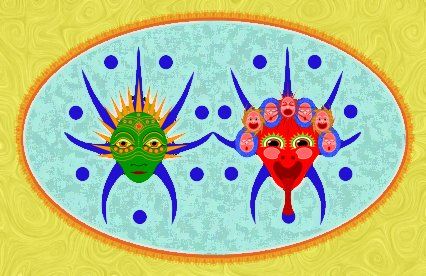
While they were consumed in the desperate times immediately following the Killing Swath, their actual value was realized in refining their potent venom. Not only was it toxic enough in raw form to dart and kill an adult Suvuka, but with patient finishing, initially, before the Tatchlan System
was brought back to life, and then with the reintroduction of specialized Invocates, it became a potent medicine for certain brain disorders and powerful Vision Window. For all these uses, they are now raised in isolated pools under the direct supervision of the Wellbeing Ministry. This is the only Fishery Craft Emblem that does not depict the creature but the Wellbeing Ministry, which oversees its production and maintenance. This is in accordance with the president set by the Venerable Koru, who have their ancient version of this same image.
Worms
Kamin
These worms live in the gut of all Fishery Craft schools to varying degrees. Kamin is plentiful within Gelfion
and few within Nemain. These worms are passed from mothers to young and have a symbiotic residence inside them. On average, there are between seven hundred to one thousand Kamin in an adult-harvested Gelfion. They serve various functions, including attacking any swallowed pests or parasites attempting to establish themselves within the giant fish. While dead Kamin is naturally excreted, a live worm is occasionally ejected into the waters. Once outside the fish, they can become a hazard and are preyed on by attendant species swimming with the schools.
Vertum
Unlike Kamin, these worms live outside the fish, forming an undulating network of tiny hairs around their mouths and other orifices. They serve as cleansers and guardians against incursion, easily distinguishing between food going in and waste coming out for unwanted activity for their colossal host. They also serve as an indicator for ageing, damaged or dying host by abandoning their post. This signals the attending Camalus
to single out and separate this fish from the school.
Kamad
Commonly called ‘Eye Fish,’ these are small species of worm that live within the eyes of Halahala. They provide two specialized services to the fish and one to the cluster tending them. The first two result from raw life, and the other is a refinement within the Tatchlan System. The raw service involves modifying their large eyes in the open air when they exit the water. When the Halahala
schools dive to the depths of their enclosure, these worms glow to make their environment and each other more visible. The most-ancient Tatchlan refinement appears when the fish is sufficiently aged or has an early onset of an illness. The Kamad now illuminates when the creature is at the surface, alerting the cluster to their harvest time. This is an example of highly delicate work within the Living System.
Pomale
This giant worm species has a unique feeding strategy, in length and girth greater than an adult Uzumal
serpent. It has a series of six thin tentacles surrounding its mouth, and it can position itself at the surface while swimming in a circular formation. It extends its tentacles in a spiral formation, often with small items, living or nonliving, in one or more of its arms. This attracts small birds and insects who attempt to pluck them out of the water, only to discover their powerful sting too late. Pomales prefer still waters and so are found in small lakes and ponds.
Pomales and Halahala
Halahala is the only species of edible fish able to tolerate their venom and consume this worm, which has few natural predators. These worms are grown and collected from all other fish farms for seeding in Halahala ponds. The worm’s hunting strategy leads to consuming flying insects and birds the Halahala would seldom consume otherwise. Their digested toxins are transmuted within the Halahala’s system into enrichment for their flesh and oil.
Invisibles
Airmund
Also named the ‘Purple Net,’ Airmund are minuscule beings living in colonies numbering in the millions. They swim in an expanding and contracting formation, spreading invisibly and then coalescing into dense clouds. These condensed clouds form a ‘net’ around their largest prey, particularly rogue Uzumal
and Kamin, along with any raw life, threatening the schools finding their way into Fishery Craft waters. Beyond these rare feasts, the Airmund generally oversees the invisible flora and fauna of the waters, fortifying beneficial elements while scouring the waters for various harmful ones. They are seeded into Gelfion
and Camalus lakes and ponds. They usually dwell at a lower layer of water to these schools and their attendants, coming to the surface at dawn where they appear to cleanse the top layer before sinking to allow the broad blue backs of the Gelion to break the surface. Airmund is considered a significant achievement of the early Tatchlan Invocates, who converted them from the menace they once were.
Chupukam
Chupukam, also named the ‘Rainbow Serpent,’ are tiny beings only visible when millions gather in formation. Their primary diet is algae and other potentially harmful plant life, and they spend much of their cycles feeding well below the surface. Chupukam also will feed on dead fish when available. Given other controls, this is seldom an option, but in one case, it is encouraged. Camalus, the companion and protector of the ‘Stately Gelfion,’ is improved if not immediately removed from the water after death. The Chupukam quickly seeks out the carcass and, in a few hours, infuses it with unique chemical additions, thereby converting it into the highly desirable ’Chupukam Camalus.’
Rainbow Serpent Formation
Chupukam surfaces together at irregular intervals, usually at midday when Nu
is hottest, where they form spectacular displays of long undulating lines composed of brilliant coloured strands of every shade. This formation is only seen in full day and appears to break down Nu’s light into different bands, which shift and change rapidly with the light. For this reason, they are collectively known as a ‘Rainbow Serpent,' and many depictions, poems, songs and other artworks are devoted to them. When examined under high magnification, their bodies reveal thirty-two distinct classes, each characterized by highly specialized body formations, which link together in specific combinations to bring the Rainbow Serpent formation about.
Waterfowl
While most of these attendants are also fish or other creatures of water, specialized species of waterfowl have also been cultivated to serve this refined environment.
Varox
This is the one species listed here for which neither its flesh nor eggs are edible. It is prized for its physical beauty and the grace and utility of its call. The Varox has a long head, neck and body standing on stately slim legs. They spend most of their time in the mud of river and lake banks, searching for the many beings dwelling just below the damp surface.
Despite their proximity, Varox has no taste for the Halahala, the ‘Walking Fish,’ who make excursions out of the water to these same banks. Their call is said to be elegant and serve Fishery Craft by signalling uniquely when an unusual event happens on the waters. This may be a dead or ailing fish at the surface or some unusual school activity. Those attending the schools always know to investigate thoroughly when the Varox warns.
This emblem depicts another distinct characteristic of this bird, the practice of, once laid, scooping up and carrying their eggs nestled in their long feathers on their back. Once hatched, the chicks spend their infancy there as well. This symbol is also associated with the Danam Yelda’s emblem for the Third Virtue of Openness. Details may be found in the Cluster Virtues
section. They may be seen in many artistic representations throughout Statos-Vey
and beyond, most notably in the colossal statues outside Upata-Shepsus
on the Imperial Way.
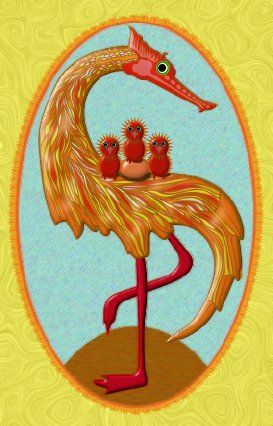
Kishilion
This is a small but spectacular bird with its dazzling iridescent purple and yellow plumage and several unique features. Most notable is eight long legs with broad web feet. With this many legs, it quickly propels itself across ponds and small lakes in search of water insects and other small game. These multiple legs are quite serviceable on land but best employed in water. It also has a unique set of growths forming what looks like a long antenna up from its head, ending in a hollow tube forming a ring. These make a singular ping when struck against each other, which the bird easily controls to produce a long series of musical calls. They are also used during elaborate courtship rituals for many mates. It is said no two sets of Kishilion rings are the same, so their songs are always of note.
While adult Kishilion is inedible, their tiny eggs are considered a supreme delicacy. Despite their size and diet, they may produce vast quantities of eggs over their modest lifespan. Attending clusters take great care to shelter them in inclement weather and enrich their diet for the sake of their eggs.
A final feature unique to this bird is their habit of laying batches of between three to eight eggs and carrying them under their wings as they travel.
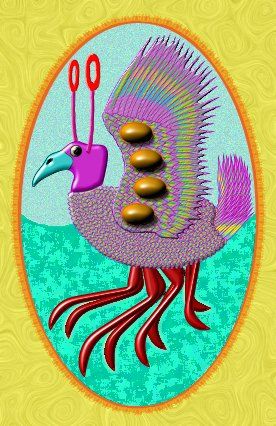
Aside from the far larger Varox, this is the only bird to carry their eggs continually. Casual close examination will reveal small raised white growths
all over this creature’s skin and legs, displaying it as a creature significantly worked on within the Living System
during the Primary Epoch. Its extravagant features lead many to presume this was an early Tatchlan work and a symbol of the Living System in the Greater Era.
The Kishilion do not open their wings while carrying their eggs. The display of the eggs under their wings in their emblem
is an artistic convention. While they are not the subjects of fun to the same extent as the Raiden and Raideneth (see immediately below), the Kishilion’s novel appearance has also led to their becoming comedic tropes in dance and theatre.
Raiden and Raideneth
This large bird has the distinction of changing sex once a year. One year, an individual tagged bird will be a male, called a Raideneth, responsible for fertilizing four to eight females throughout the season. These female birds are named Raiden. The same bird will become an egg-bearing Raiden herself the following year, only to switch back to being a Raideneth the following year. Depending on the weather that year, the change occurs between Two-Week
One, Atra and Two-Week Four, Ingeen.
Raiden prolific egg layers
The female Raiden are prolific egg layers. Chicks grow into adults during the first season and manifest as Raiden the following year. During their first full year as Raiden, they are repeatedly fertilized but lay no eggs. This is followed by their second year, where they function as fertilizing Raideneth. In the third year, they are Raiden and begin laying eggs. Third and Fifth year Raiden is the most prolific, on average laying up to ten eggs every two week. In central Statos-Vey, their egg-laying season usually commences on or just before Mid Year between Two-Week Thirteen, Rakal, and Two-Week Fourteen, Min. It continues to near year’s end, Two-Week Twenty-Six, Kavuk, and Two-Week Twenty-Seven, Alatahanu.
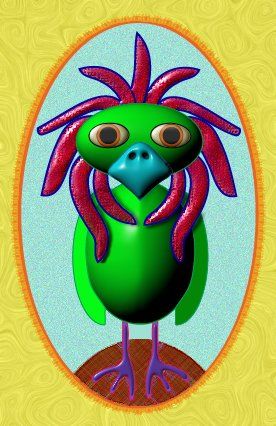
These Third and Fifth Year Raidens produce an average of one hundred and forty to one hundred and sixty eggs during this time. By the time they are Raiden again in their seventh year, they produce far fewer eggs, but these are highly prized. Traditionally, all birds are caught and eaten at the beginning of their eighth year. These eggs are considered second-grade compared to Kishilion
eggs, but unlike the Kishilion, the Raiden may be eaten. They are also a delicacy to many predators, illustrating the waste of Raw Life, allowing most of their chicks to be consumed before reaching maturity.
Associated with comedy and fertility
The Raiden is also known for its comical appearance due to its startling eyes and elaborate iridescent red ‘headdress.’ This waving set of extravagant tubes is covered in millions of tiny feathers and scales in contrast to its near-uniform small green feathers on the rest of its round body. They are employed in a wide variety of displays, where, among other things, they can inflate and deflate one or all of their set. This is observed with great hilarity. These features and behaviours have led to many familiar absurd, satirical, and slapstick-related images in street theatre. The ‘Raiden Mask’ is a standard part of the comedic theatre. This tradition goes back to the Everlasting Ennui, where Raiden masks, costumes and behaviour emphasize farcical elements of two of the ten plays of the collection, the ‘Sime’ and ‘Laranal.’ Due to their changing sexes, they are associated with delight and fertility and are Kava-Kura
icons during her festival. This emblem reflects this cultural overlay in as much as the amusing aspects of the creature are somewhat exaggerated, although this distortion has always been viewed as affectionate. While most of these images are light-hearted, a distinct version of them is given out as Bestowals
during the annual Kava-Kura Festival
on Elder Candle Day (99) in Month Six, known as Tret, linking this humble bird with the Tatchlan Face of Vital Delight.
Protection during Burning Blossom events
Later in the Primary Epoch, it was determined that what had initially been a beneficial ‘Blossom’ was becoming a catastrophic Burning Blossom
event. This was a general malady was a particular threat to Fishery Craft Farms. While often well-informed of the approaching calamity, these areas of open fresh water provided their Portents. Trembling waters, toxic bubbles, and sudden aberrant fish behaviour were all signs. In particular, Roaring Whirlpools
were strong indicators of an immanent event.
If not before, such signs saw a variety of strategies being employed in different locations, most having to do with sheltering a portion or all of a pond or lake during the worst days of a Burning Blossom Cycle. This could be huge canopies fixed over the water or floating sectional material deflecting ‘Nu’s Malignant Eye.’ Extensive underwater caves and areas under overhanging rock were fortified or fashioned. Whatever form the protection took, these large sheltered areas were cordoned off from any exposed water to keep the Gelfion
and others within the protected area during the day. It was found that morning and midday were the most dangerous, with late-day exposure being deemed less harmful. Even if the exposed area had no significant schools, other life would suffer and thus affect the protected fish, leading to various initiatives to cover vast water areas. When Living Upata Bulbs
existed in the Emaxul Age, great interest was shown in developing living skin to ensure the Fishery Craft survived as the Blossom became increasingly virulent.


